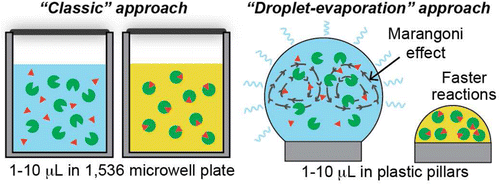Moving diagnostics out of the microwell

On many TV shows that depict chemistry in action, scientists are shown using bulky flasks and metal vats to perform reactions. In real labs, countless chemical reactions occur in microwells on small plastic plates. Scientists have relied on them for years in diagnostics and other applications, but that could change with a new approach that uses tiny, evaporating droplets suspended on "pillars." Researchers report the technique in ACS' journal Analytical Chemistry.
Scientists have long relied on the 96-well microplate for analyzing samples of blood, DNA and other substances. An entire industry has developed around these plates' usefulness. There are automatic plate readers, pipettes and robots all designed to 96-well specifications. To lower costs and perform faster analyses, however, plates have been made with more—and tinier—wells, up to 3,456 of them on a plate. But the 1 to 10 microliters of liquids that go in those wells become very difficult to mix, a key step that facilitates reactions. Jose L. Garcia-Cordero and colleagues came up with a way to handle this problem.
The researchers fabricated plastic sheets the same size as the traditional microplates, but instead of wells, they dotted them with 1-millimeter tall pillars, 96 per sheet. On the tips of the pillars, the researchers balanced 10-microliter droplets of liquid solutions. As the drops evaporated, their contents mixed thanks to the Marangoni effect, a phenomenon that is also responsible for the "tears" of wine that run down the sides of a glass. They also changed color within minutes to indicate that a particular reaction took place. The pillars could become a low-cost platform for medical diagnostics, the researchers say.
The authors acknowledge funding from the Fundación Miguel Alemán and the National Council for Science and Technology (CONACyT) of Mexico.
More information: Ruth Hernandez-Perez et al. Evaporation-Driven Bioassays in Suspended Droplets, Analytical Chemistry (2016). DOI: 10.1021/acs.analchem.6b01657
Abstract
The microtiter plate has been an essential tool for diagnostics, high-throughput screening, and biological assays. We present an alternative platform to perform bioassays in a microplate format that exploits evaporation to drive assay reactions. Our method consists of droplets suspended on plastic pillars; reactions occur in these droplets instead of the wells. The pillars are fabricated by milling, and the rough surface created by this fabrication method pins the droplet to a constant contact line during the assay and also acts as a hydrophobic surface. Upon evaporation, natural convection arising from Marangoni currents mixes solutions in the droplet, which speeds up assay reactions, decreases assay times, and increases limits of detection. As a proof of concept we implemented two colorimetric assays to detect glucose and proteins in only 1.5 μL, without any external devices for mixing and with a digital microscope as a readout mechanism. Our platform is an ideal alternative to the microtiter plate, works with different volumes, is compatible with commercially available reagent dispensers and plate-readers, and could have broad applications in diagnostics and high-throughput screening.
Journal information: Analytical Chemistry
Provided by American Chemical Society





















